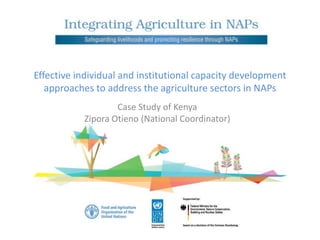
Kenya – Capacity Assessment
- 1. Effective individual and institutional capacity development approaches to address the agriculture sectors in NAPs Case Study of Kenya Zipora Otieno (National Coordinator)
- 2. Outline of presentation Introduction and Background Objectives of the assessment Scope of the Assignment Approach and Methodology Assessment Results Capacity Development Process Lessons/challenges
- 3. Introduction & Background • Capacity Assessment was commissioned by the FAO and UNDP Kenya representations under the auspices of the NAP- Ag project. • Project implemented in 11 countries-Africa, Asia and Africa. • Kenya is part of the NAP-Ag programme. • Four outcomes are envisaged in the programme. a. Strengthened technical and institutional capacity on NAPs b. Integrated roadmaps for NAPs developed c. Evidence-based results for NAPs improved d. Advocacy and knowledge-sharing on NAPs promoted
- 4. Objective of the Assessment • To identify key capacity gaps (technical and functional) in key MDAs and assess the degree to which they are aligned to deliver on their mandate, and • To develop a Capacity Development Plan that can be implemented during and after the life of the project
- 5. Scope of the Assessment • Collecting and analyzing information from previous capacity assessments; • Assessing current roles, responsibilities and capacities of the institutions for climate change adaptation planning; • Identifying the capacity gaps, both individual/ technical and institutional; • Based on the gaps, identify opportunities and entry points for strengthening the institutions as well as capacities of technical staff in the climate change related units/departments; • Develop a Capacity Development Plan for each institution assessed.
- 6. Institutions Assessed i. Ministry of Agriculture, Livestock and Fisheries ii. Ministry of Environment and Natural Resources iii. Ministry of Devolution and Planning iv. Ministry of Water and Irrigation v. National Drought Management Authority vi. The National Treasury-NDA for the Green Climate Fund in Kenya
- 7. Approach and Methodology Phase 1: Literature Review. • Literature review: Review of Strategic Plans for the parent Ministry, relevant policies and Acts. • lnitial Contacts: Attendance of launch of the NAP, made initial contacts and appointments. • Review of the NAP and Climate Change Act. • Develop questionnaire. Phase 2: Face to face Interviews. • Circulate Questionnares to each Climate Change Unit. • Face to face meeting with Climate Change Unit staff, presentation of background to the assignment, elaboration of methodology, and guidance on how to fill the questionnaire. • Open discussion on the key issues, challenges and opportunities for capacity development Phase 3: Self assessment using questionnaires. • Reflection by key staff and self assessment using the questionnaire (each was given two days for this). • Data compilation and analysis of the returned questionnaires for each MDA CC Unit. • Preparation of capacity assessment report for each MDA CC Unit. • Capacity Development Plans
- 8. Approach and Methodology The Approach was informed by two Frameworks, namely: The UNDP Capacity Needs Assessment Framework (CNAF) and The World Resources Institute’s (WRI) National Adaptive Capacity (NAC) Framework .
- 9. Approach and Methodology • Four Functional Capacities were defined for the assessment: Policy and Normative Capacity - (What are the capacity strengths for policy formulation and implementation?) Knowledge Management Capacity - (What capacity exists to generate, share and adapt relevant knowledge?) Partnering Capacity - (What capacity exists to engage Partners, actors and stakeholders?) Implementing Capacity – (What capacity exists to implement, monitor and evaluate relevant projects/programmes).
- 10. Approach and Methodology • Each of these functional capacities were assessed in three dimensions: Enabling Environment, The Organization, Individual Capacity.
- 11. Assessment Results for State Dept. of Agric Score on a scale of 1-5 (1=Very Low; 2=Low 3= Moderate 4=High 5 = Full Capacity)
- 12. Summary Analysis: Capacity Assessment for State Dept. of Agriculture Action: Enhance Resilience in the Agriculture Value Chain SCORE Score on a scale of 1-5 (1=Very Low; 2=Low 3= Moderate 4=High 5 = Full Capacity) Short Term KNOWLEDGE CAPACITY (What capacity exists to generate, share and adapt relevant knowledge) Dimension 1: Enabling Environment 1.3 Dimension 2: The Organization 2.5 Dimension 3: Individual Capacity 1.5 PARTNERING CAPACITY (Capacity to engage actors, partners, and stakeholders). Dimension 1: Enabling Environment 2.8 Dimension 2: The Organization 3.1 Dimension 3: Individual Capacity 1.6 CAPACITY TO IMPLEMENT (Capacity to implement and evaluate relevant programmes) Dimension 1: Enabling Environment 1.3 Dimension 2: The Organization 2.5 Dimension 3: Individual Capacity 2.4
- 13. Summary for priority Capacity Development Priority Capacity Development Focus. Current Level Knowledge : Enabling Environment 1.3 Knowledge : Individual Capacity 1.5 Partnering: Individual Capacity 1.6 Implementation: Enabling Environment 1.3 Implementation: Individual Capacity 2.4
- 14. Qualitative Assessment • Typically involved face to face interviews with the CCU teams. • Staff were encouraged to provide additional qualitative information when providing responses to the questionnaires. These were summarized to show the existing strengths, weaknesses and prioritized needs.
- 15. Capacity Development Process • Already underway • Primary stakeholders meeting held in early January 2017 to identify potential areas of support under the NAP-Ag project. • To this end, four areas of support have been identified and incorporated in 2017 workplan. • Resource mobilization for a broader capacity development programme underway (GCF NAP Readiness funding window). • Resource-mobilization led by Govt and FAO
- 16. Lessons Learnt • Policies, Strategies and Action Plans to facilitate climate change adaptation planning exist. The main challenge lies in implementation. • Knowledge generation is not a problem. Main challenge lies in packaging the information to different end-users and/or duty bearers. • The assessment offers a great opportunity to incorporate the priority actions in the NAPs. • “Silo” approach to adaptation planning and implementation within the agric sub-sectors (weak partnering capacities)
- 17. Challenges • Only a few countries have done capacity assessments for climate change adaptation planning-most assessors are either good at conventional institutional capacity assessments or climate change adaptation implementation. Finding an assessor with a blend of expertise was difficult.
- 18. THANK YOU
